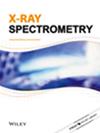用共聚焦微x射线荧光成像原位观察锌底漆钢板在NaCl溶液中的电化学反应
IF 1.5
4区 物理与天体物理
Q3 SPECTROSCOPY
引用次数: 0
摘要
钢板已广泛应用于桥梁、车身、护栏等。一般为了提高耐蚀性,在钢板表面涂上一层锌层。但是,当涂层钢板受到外界因素的划伤时,其耐腐蚀性下降。因此,阐明涂层和钢板中元素的洗脱过程对开发新型涂层和改进耐腐蚀技术具有重要意义。在腐蚀过程中,被镀层金属和铁之间发生洗脱反应(阳极反应)和氧的还原反应(阴极反应)。用共聚焦微x射线荧光成像技术观察了阳极和阴极钢板的洗脱过程。将锌底漆钢板划伤后浸入氯化钠溶液中。通过恒流器对两个钢板施加恒流,观察了锌在阳极侧的洗脱过程。没有发生Fe的析出过程,我们认为Zn的牺牲保护抑制了这一过程。在钢板的阴极侧未观察到Zn和Fe的洗脱。利用所提出的方法,我们成功地可视化了钢的阳极和阴极两侧的元素分布。本文章由计算机程序翻译,如有差异,请以英文原文为准。
In situ observation of electrochemical reaction of Zn primer steel plate in NaCl solution using confocal micro‐x‐ray fluorescence imaging
Steel plates have been widely used in bridges, vehicle bodies, guardrails, and so forth. Generally, to improve corrosion resistance, the surface of a steel plate is coated with a Zn layer. However, when the coated steel plate is scratched by external factors, the corrosion resistance decreases. Therefore, it is important to elucidate the elution processes of elements in coated layers and steel plates to develop new coated films and improve corrosion‐resistant techniques. During corrosion, an elution reaction between the coated metal and Fe (anodic reaction) and a reduction reaction of oxygen (cathodic reaction) occur. Confocal micro‐x‐ray fluorescence imaging was employed to visualize the elution processes at the anodic and cathodic steel plates. A Zn primer steel plate was scratched and then immersed in sodium chloride solution. The Zn elution process at the anodic side was observed when a constant current was applied to the two steel plates by a galvanostat. The Fe elution process did not occur, and we believe that the sacrificial protection of Zn inhibited the process. The elutions of Zn and Fe were not observed on the cathodic side of the steel plate. Using the proposed method, we successfully visualized the elemental distributions at the anodic and cathodic sides of the steel plates.
求助全文
通过发布文献求助,成功后即可免费获取论文全文。
去求助
来源期刊

X-Ray Spectrometry
物理-光谱学
CiteScore
3.10
自引率
8.30%
发文量
38
审稿时长
6-12 weeks
期刊介绍:
X-Ray Spectrometry is devoted to the rapid publication of papers dealing with the theory and application of x-ray spectrometry using electron, x-ray photon, proton, γ and γ-x sources.
Covering advances in techniques, methods and equipment, this established journal provides the ideal platform for the discussion of more sophisticated X-ray analytical methods.
Both wavelength and energy dispersion systems are covered together with a range of data handling methods, from the most simple to very sophisticated software programs. Papers dealing with the application of x-ray spectrometric methods for structural analysis are also featured as well as applications papers covering a wide range of areas such as environmental analysis and monitoring, art and archaelogical studies, mineralogy, forensics, geology, surface science and materials analysis, biomedical and pharmaceutical applications.
 求助内容:
求助内容: 应助结果提醒方式:
应助结果提醒方式:


